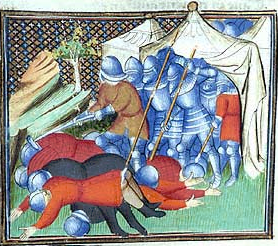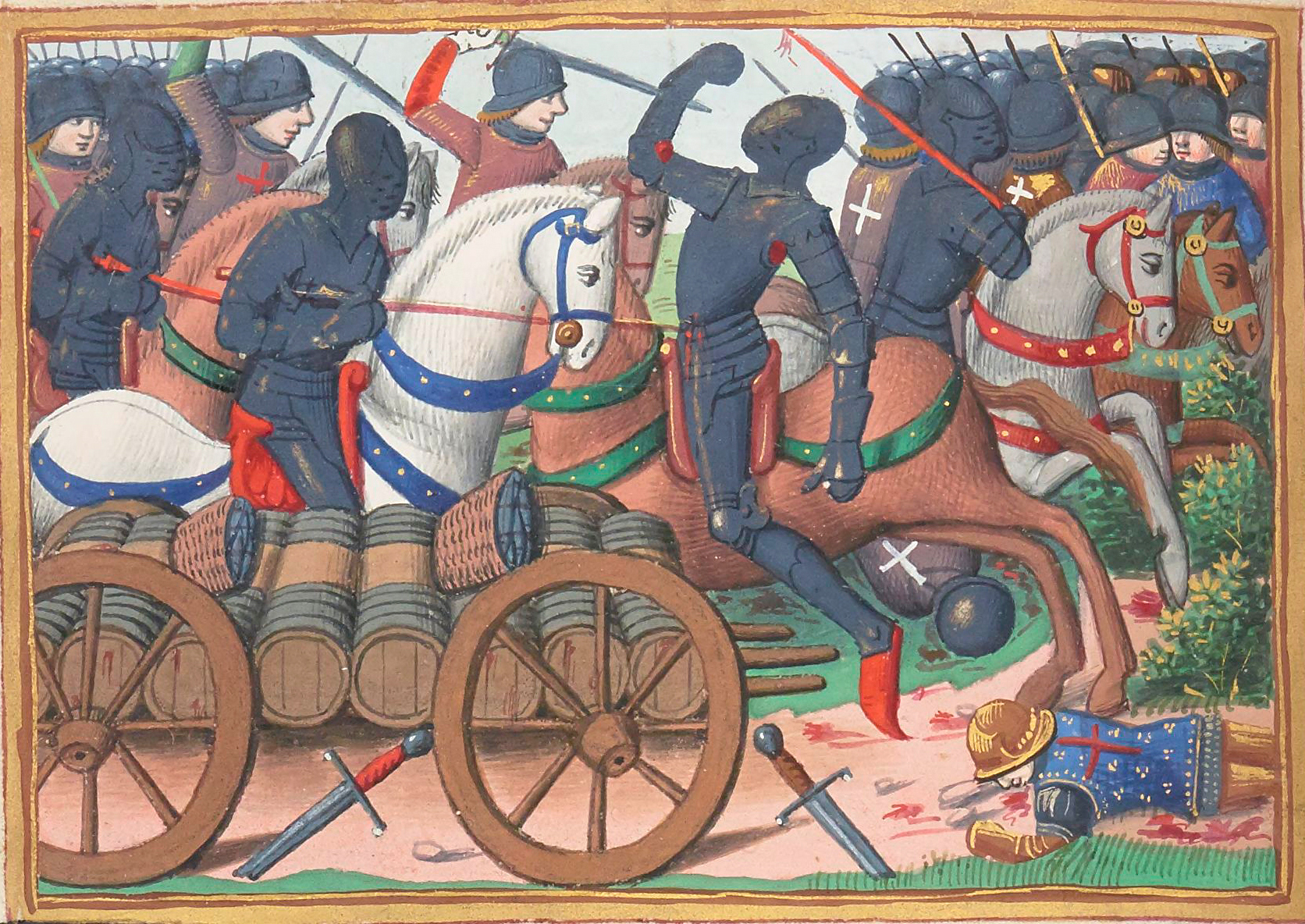 |
| Xaintrailles and La Hire |
Fighting the English
In 1421 Jean
was made a knight and took as his arms the arms of the house of Orléans with
the bend sinister. On 24th November Jean was
given the Lordship of Vaubonais-Dauphine by Charles de Ponthieu. The following year Jean married his first wife, Marie Louvet. Marie was the daughter of Jean
Louvet[i],
Lord of Eygallières, chairman of the parlement of
Provence and one of the king’s ministers.
In 1421 Jean
was created Viscount of Saint-Sauveur[ii], baron of Parthenay and Lord of Valbonnais. The following year Fallavier[iii] was added to his domains
and then Longueville[iv].
Jean was forced into exile for a year when his father-in-law and his family
were banished by the king.
 |
| Chateau de Beaugency |
Jean
took up with La Hire and Poton de Xaintrailles in confronting the
English when the opportunities arose. La Hire was known for both his swearing
and praying and his relationship with his god was very personal;
‘Lord God, I
pray you to do for La Hire what La Hire would do for you if God was a captain
and La Hire was God.’[v]
This
small force managed to make the English occupation uncomfortable, even
re-capturing Le Mans for a short time. Jean fought
for his master when the Dauphin won the battle at Baugé on 22nd March 1421 and when he was defeated at Cravant in 1423. Jean was also involved in the defence
of Blois. In 1422 Jean purchased (or was given) the château de Beaugency.
The Fight Goes On
 |
| Battle of Meaux |
On
31st August 1422 Henry V died from dysentery contracted at the siege of Meaux. His brother Bedford was to be regent for
Henry’s baby son Henry VI[vi]. Less than two months
later, on 21st October 1422, Charles VI died and the English
immediately proclaimed Henry VI king of France as agreed at Troyes. The Dauphin seemed unable to act on his own initiative and
his favourite Georges de la Trêmoille and the Archbishop of Rheims, Renauld de Chartres,
were unable to press him into action.
The
next few years saw Jean on the road, fighting against the English. As a reward
for his efforts in March 1424
Charles VII made Jean Count of Mortain[vii]; five months later Jean was present at the French
defeat at Verneuil[viii] on 17th
August 1424. In
December 1424 the
County of Gien was also made over to him. In 1425
Jean was one of those who helped defend Mont St. Michel[ix]. The following year Jean
was appointed Captain of Mont-St-Michel. Jean’s wife Marie died in 1426.
 |
| Montargis |
On 5th
September 1427, in tandem with La Hire and a force of sixteen hundred men, Jean
was to successfully come to the aid of Montargis under siege from the English led by
the Earl of Warwick and the Earl of Suffolk. La Hire and Jean fell on the
English forces and captured Suffolk’s brother[x] and most of the English
cannon; a success Charles VII called;
Jean’s fame for his prowess
and his inspiring and unconventional attack on the besieging forces started at Montargis
after which he was made a Lieutenant General. In 1428 the county of Porcien was added.to Jean’s
domains.
 |
| Battle of Rouvray |
‘To
Monseigneur the Bastard of Orléans, 12 men-at-arms and 2 archers etc, one
hundred and four livres tournois[xiv].’[xv]
Jean seemed rather
lacklustre in defence, but led an attack on the English in December 1428 and
another sortie in January. Jean
was wounded, barely escaping with his life according to the siege journal, at
the French defeat at the Battle of Rouvray[xvi] in February 1429.
The
siege was well under way when the appearance of the woman who was to become
known as Joan of Arc
made her appearance at court, being held at Chinon. With her claims of heavenly intercession Joan was to
inspire Charles VII to defend his inheritance. Jean declared that he heard;
 |
| Joan of Arc |
‘Rumours from the town of
Gien….that a certain young woman, commonly called the Maid, asserted that she
was going to the noble dauphin to raise the siege of Orléans and to lead the
dauphin to Rheims.’[xvii]
Joan was
able to persuade Charles to allow her to accompany the army that was to lift
the siege. Once there Joan was able to inspire the defence, although she was
displeased that upon her arrival she was taken into the town rather than
directed towards the fighting. Joan took issue with Jean because he was not
prepared to take up arms.
On 1st
May Jean departed Orléans for Blois to confer with Charles I, Duke of Bourbon, and to collect troops to add to the town’s defences,
intending to return by 4th May. Joan spent the time reconnoitring
and endearing herself to the townspeople. Seven days later the fighting[xviii] was over and the
English were retreating; Joan’s determination had won the day.
Carry On Winning
.jpg) |
| Battle of Jargeau |
Joan, Jean
and the other French leaders joined the dauphin at the chateau[xix] of Loches. They hoped to persuade Charles to allow them more troops to harry the
English along the Loire valley. Charles agreed to send Jean, the duke
of Alençon and other
of his captains with Joan to recover Meung, Beaugency and Jargeau.
On 11th
June Joan attacked the English at Jargeau; five days
later at the battle of Meung Joan, along with Jean, Poton de
Xaintrailles, Alençon and Gilles de Rais, fought the English over control of the strategically placed
bridge over the Loire at Meung. They took the bridge;
‘By frontal assault, hardly
causing a moment’s pause.’[xx]
| Battle of Patay |
Their
victory was to impede English supply and communication lines throughout the
region. On the 16-7th the French once again fought the English at
the battle of Beaugency. Burgundian chronicler Jean de Waurin wrote;
‘The French were alerted of
their [the English] approach, with around 6,000 soldiers, of which the leaders
were Joan the Maid, the duke of Alençon, the Bastard of Orléans, the Marshall
of La Fayette, La Hire, Ponton and other captains. They ordered their soldiers
into battle formation on top of a small hill.’[xxi]
On the
following day Joan’s army fought again at the battle of Patay, another victory for the French when the English fled the
field for the safety of Paris. The army returned to Orléans the following day
and finally met with the court at Gien on 24th June where Joan was
able to persuade the dauphin to go to Rheims.
Bibliography
The Real Bluebeard – Jean Benedetti,
Sutton Publishing 2003
The Hundred
Years War – Alfred Burne, Folio Society 2005
The Real
Falstaff – Stephen Cooper, Pen and Sword Military 2010
Joan of Arc
– Kelly DeVries, the History Press 2011
The Reign of
Henry VI – RA Griffiths, Sutton Publishing Ltd 1998
The
Fifteenth Century – EF Jacob, Oxford University Press 1997
Louis XII –
Paul Murray Kendall, Sphere Books Ltd 1974
Joan of Arc
– Edward Lucie-Smith, Classic Penguin 2000
John Talbot
and the War in France – AJ Pollard, Pen and Sword Military 2005
Philip the
Good – Richard Vaughan, Boydell Press 2014
www.wikipedia.en
[iv]
Again it is not possible to identify which particular Longueville is referred
to
[v]
Orléans 1429 - Nicolle
[vi]
Who inherited his grandfather’s insanity
[viii]
Where the French army was bolstered by the addition of 4,000 Scottish soldiers
[ix]
Which was never taken by the English during
the war
[x]
Probably John de la Pole who died in 1429 while still a prisoner of the French
[xi]
‘The beginning and the cause of our happiness’
[xii]
The Hundred Years War - Burne
[xiii]
The enemy commanders were Suffolk, Salisbury and Talbot
[xiv]
In 2015
the relative: historic standard of living value of that income or wealth is £64,310.00 labour earnings of that income or wealth is £637,100.00 economic status value of that income or wealth is £1,987,000.00 economic power value of that income or wealth is £35,250,000.00 www.measuringworth.com
[xv]
Orléans 1429 - Nicolle
[xvi]
Also known as the Battle of the Herrings; see http://wolfgang20.blogspot.co.uk/2014/12/shakespeares-buffoon-iii.html
[xvii]
Joan of Arc - DeVries
[xix]
One of the dauphin’s favourite residences
[xx]
The Real Bluebeard - Benedetti
[xxi]
Joan of Arc - DeVries
No comments:
Post a Comment
Note: only a member of this blog may post a comment.